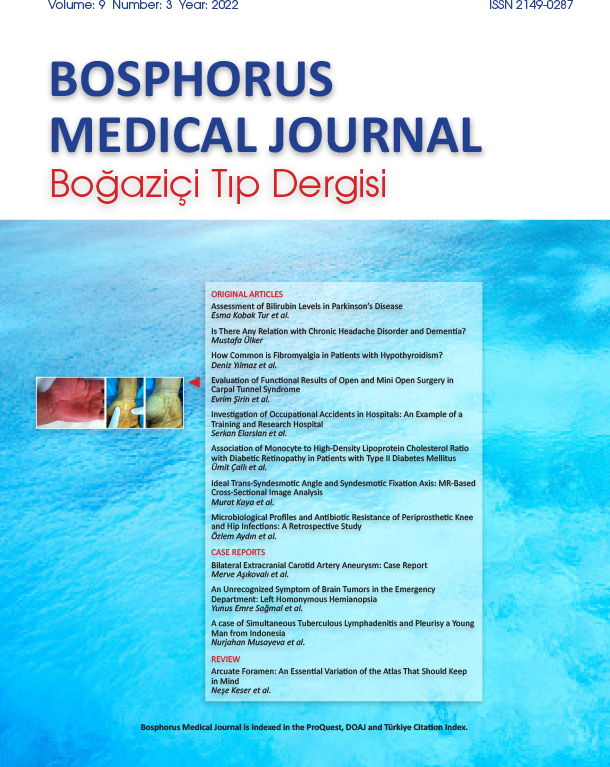Eldeki Falangeal Benign Yumuşak Doku Tümörlerinin Değerlendirilmesi ve Literatürün Sistemik İncelenmesi
Numan Atılgan1, Mehmet Rauf Koç2, Numan Duman3, Turgut Emre Erdem4, Onur Bilge41Mehmet Akif İnan Eğitim ve Araştırma Hastanesi, El Cerrahisi Anabilim Dalı, Şanlıurfa, Türkiye2İzmir Tepecik Eğitim ve Araştırma Hastanesi, El Cerrahisi Anabilim Dalı, İzmir, Türkiye
3Üsküdar Üniversitesi Tıp Fakültesi, Npistanbul Beyin Hastanesi, Ortopedi ve Travmatoloji Anabilim Dalı, İstanbul, Türkiye
4Necmettin Erbakan Üniversitesi Meram Tıp Fakültesi, Ortopedi ve Travmatoloji Anabilim Dalı, Konya, Türkiye
GİRİŞ ve AMAÇ: Bu çalışmanın amacı, eldeki falangeal benign yumuşak doku tümörlü hastaları ve cerrahi sonrası kısa dönem komplikasyonlarını değerlendirmektir.
YÖNTEM ve GEREÇLER: Ocak 2019-Ekim 2021 tarihleri arasında falanks yumuşak doku tümörlü 59 hasta (31i kadın, 28i erkek; ortalama yaş 48,96±13,33 yıl, dağılım 20-75 yıl) demografik veriler, histopatolojik tanı, memnuniyet düzeyi, nüks ve komplikasyonlar açısından değerlendirildi.
BULGULAR: En sık görülen falanks yumuşak doku tümörü tenosinovyal dev hücreli tümörlerdi (n=15, %38,4). Diğer sık görülen histolojiler ise ganglion kistleri (%12,8), epidermal inklüzyon kisti (%10,25) ve fibrolipom (%7,6) idi. Yumuşak doku tümörleri en sık ikinci ve üçüncü falankslarda (her ikisi de %26,2) bulunurken, bunu dördüncü (%13,8), birinci (%12,3) ve beşinci (%9,2) falankslar takip etti. El falanksında tümörler %40 proksimal, %29,2 distal ve %30,8 falanksın farklı bölgelerindeydi. Ortalama VAS skoru eksizyonel cerrahi öncesi 5,9±3,1 idi; son kontrolde 3,47±1,3 idi (p<0,01). Yedi hastada ameliyat sonrası nüks görüldü (%11,8). Cerrahi alan enfeksiyonu diğer komplikasyondu ve 3 (%5) hastada tespit edildi.
TARTIŞMA ve SONUÇ: Deneyimlerimiz, en sık gözlenen yumuşak doku falanks tümörlerinin tenosinovyal dev hücreli tümörler olduğunu gösterdi. Falanksın yumuşak doku tümörlerinin eksizyonel cerrahi tedavisi, iyi memnuniyet oranları ve düşük nüks ve komplikasyon oranları elde etmek için dikkat gerektiren bir cerrahidir.
Evaluation of Phalangeal Benign Soft-Tissue Tumors of the Hand and Systemic Review of the Literature
Numan Atılgan1, Mehmet Rauf Koç2, Numan Duman3, Turgut Emre Erdem4, Onur Bilge41Department of Hand Surgery, Mehmet Akif Inan Training and Research Hospital, Sanliurfa, Turkey2Department of Hand Surgery, Izmir Tepecik Training and Research Hospital, Izmir,Turkey
3Department of Orthopedics and Traumatology, Uskudar University Medicine Faculty, Npıstanbul Brain Hospital, Istanbul, Turkey
4Department of Orthopedics and Traumatology, Necmettin Erbakan University Meram Medicine Faculty, Konya, Turkey
INTRODUCTION: Our aim in this study is to evaluate patients with phalangeal benign soft-tissue tumors of the hand and to evaluate their short-term complications after surgery.
METHODS: Between January 2019 and October 2021, 59 patients (31 female, 28 male; mean age 48.96±13.33, range 2075 years) with phalangeal soft-tissue tumors were evaluated according to demographic data, histopathological diagnosis, satisfaction level, recurrence, and complications.
RESULTS: The most common phalangeal soft-tissue tumor was tenosynovial giant cell tumors (n=15, 38.4%). Other frequent histologies included ganglion cysts (12.8%), epidermal inclusion cyst (10.25%), and fibrolipoma (7.6%). Soft-tissue tumors were most commonly found on second and third phalanx (both 26.2%), followed by fourth (13.8%), first (12.3%), and fifth (9.2%) The location of soft-tissue tumors was found in the phalanx of hands that were 40% proximal, 29.2% distal, and 30.8% in different parts of the phalanx. The mean visual analog scale score was 5.9±3.1 before excisional surgery; it was 3.47±1.3 at the last follow-up (p<0.01). Seven patients had recurrence after the surgery (11.8%). Surgical site infection was the other complication and seen in three patients (5%).
DISCUSSION AND CONCLUSION: Our experience has shown that the most frequently observed soft-tissue phalanx tumors are tenosynovial giant cell tumors. Excisional surgical treatment of soft-tissue tumors of the phalanx is a surgery that requires attention to get good satisfaction rates and low recurrence and complication rates.
Makale Dili: İngilizce




















